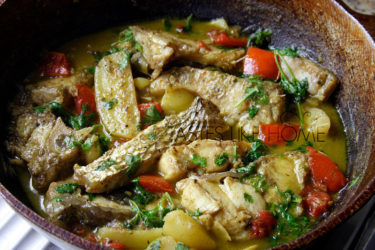Hi Everyone,
Bruise, bash, chop, crack, crush, grind, pound, smash – are among the many applications we make to ingredients when cooking. As violent as it sounds, these are necessary treatments we must employ at varying times, to extract the ideal element of an ingredient to flavour and enhance a dish.

When it is recommended that ginger be sliced thinly on the bias it means that the maximum surface area from this type of cut will facilitate a lot of the ginger flavour being released. When it is recommended that whole spices be dry-roasted just before being ground, it is to bring the oils of the spices to the surface thus creating an intensity of flavour and aroma. Nuts and dried fruits such as raisins or cranberries when added whole to granola bars are to add a chewy texture and heft. The same ingredients when added to biscotti, buns or sweet bread would be chopped small enough to be incorporated into the mixture so that it becomes one with the other ingredients providing subtle flavour.

Hot peppers tossed whole into a boiling pot of soup, rice and peas or Cook-up Rice will not impart any of its heat, but if punctured with a couple of tiny slits before being added to the pot, the pepper will release gentle heat to the entire pot. If the same peppers are minced finely or ground with their seeds and membranes the intensity of heat would be greater.
Sometimes a particular cut is recommended to breakdown an ingredient to release its flavour such as onions, tomatoes and herbs. Herbs chopped/minced finely offer up more pronounced flavour than those added whole. On the other hand, some ingredients are to be reduced to such a state – ground, puree, paste – that when cooked with other ingredients they are integrated in such a way that they become an essential part of the dish. A curry is a good example of this – the mixture of spices when ground and mixed with ground turmeric, onions, garlic, peppers, and herbs form a paste that becomes the base and foundation of the dish. All of these ingredients flavour the gravy/sauce of the curry.
Many of the same spices in garam masala when cooked whole are not as strong in flavour, it is for this reason, I always recommend a dish of Fish Molee (a Kerala style fish curry) to introduce people to curry. The curry is mild with the spices cooked whole in coconut milk. The dish is fragrant and light.
Here are some other examples to indicate how breaking down an ingredient matters and how cooking techniques contribute to their flavour profiles.
If you are making dhal/dal and decide to add the geera/cumin seeds at the beginning of the cooking process, the flavour is restrained, however, toast the geera in hot oil then pour it over the dhal and immediately the seasoning and flavour of the dal changes.
Not everyone likes the assertive flavour of garlic, for a mere hint of garlic in a dish, crush it after peeling and add to the pot/pan. For a more robust flavour, mince the garlic fine or make a paste of it.
Cracked nutmeg in a drink imparts a lighter flavour than grated nutmeg; the same goes for many other spices. Add a whole piece of cinnamon to rice pilaf and it fragrances the rice in an exotic way, add it ground up and the dish becomes over powering.
Eggs are a perfect example of how important it is to vary an ingredient when cooking. To make meatballs and other fried foods that require eggs, the eggs are cracked and added whole and mixed in. Those same eggs change function when they are to be beaten lightly to work as a wash for baked good or as a coating for foods that need a batter. When eggs are to be added to cakes, they are often beaten until they become frothy. And then there is the separation of the whites and yolks when making soufflés, meringues, angel cakes etc.
I invite and encourage you to try different ways and methods of breaking down ingredients, you will be surprised by what some ingredients reveal in terms of layers of flavour and texture.
Cynthia





